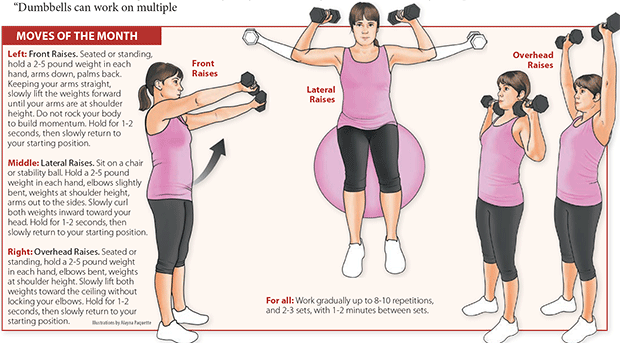Build Upper-Body Strength with Dumbbells
Dumbbells are handheld weights that are great for starting out in muscle toning and strength-training. Sizes range from 1 pound all the way up to 100 pounds and more, but you won’t need to purchase a complete set. Dumbbells can be bought individually for just a few dollars. Start with 1-3 pound weight sets (one for each hand) and work your way up to 5-8 pounds. Choose something with a vinyl covering over plain metal for a stronger, safer grip. You also can save some money by using a filled plastic water bottle, which weighs around 1-2 pounds.
Dumbbell Benefits
Dumbbells offer several key benefits: They’re inexpensive, easy to store, you can use them anywhere—at home, in a park, at a friend’s house, in a pool—and they grow with you as you improve in strength and muscle tone. Some of the key benefits to using dumbbells are increasing bone density, muscular strength and functionality, and overall mental health and well-being.
“Dumbbells can work on multiple areas of the body depending on the movements performed,” explains Jamie Osmak, certified strength and conditioning specialist at the Weill Cornell-affiliated Hospital for Special Surgery’s Sports Rehabilitation and Performance Center. “For example, you can do a seated dumbbell curl that would target the bicep or the muscles that flex the arm. If you take a similar movement like a bicep curl and now do it standing while in a slight quarter-squat position, you now are working your legs isometrically in conjunction to the arm.”
“Another great benefit of dumbbell training is that the weight is not fixed on a strict track of motion,” Osmak says. “This allows your body to work harder to stabilize your joints, which can replicate real-life situations.”
Getting Started
When starting a dumbbell program, focus on form first, Osmak says. Start light and gradually work up in weight. And you always want to pull, not push or yank your arms. “If you are unsure of form or direction, seek out a fitness professional to help guide the form and program.”
For new users, a dumbbell routine should consist of 1-2 sessions per week and build up to 3-4 sessions on non-consecutive days.
“If you already participate in a strength-training program, you can intermix dumbbell exercises within that program,” says Osmak. “You even may be able to cut out machine exercises that target a specific muscle and use a dumbbell instead.”
Determining when it’s time to move up in weight should be based on how hard the exercise feels after performing for a few weeks. “Try using a scale of 1-10,” Osmak says. “After working on a specific exercise for a few weeks, reevaluate how hard that exercise feels. If your perception of effort decreases, then increase the weight you are using. For example, if the exercise felt like a seven a few weeks ago and now it feels like a four, increase either your weight or your repetitions.”

The post Build Upper-Body Strength with Dumbbells appeared first on University Health News.
Read Original Article: Build Upper-Body Strength with Dumbbells »
Powered by WPeMatico

